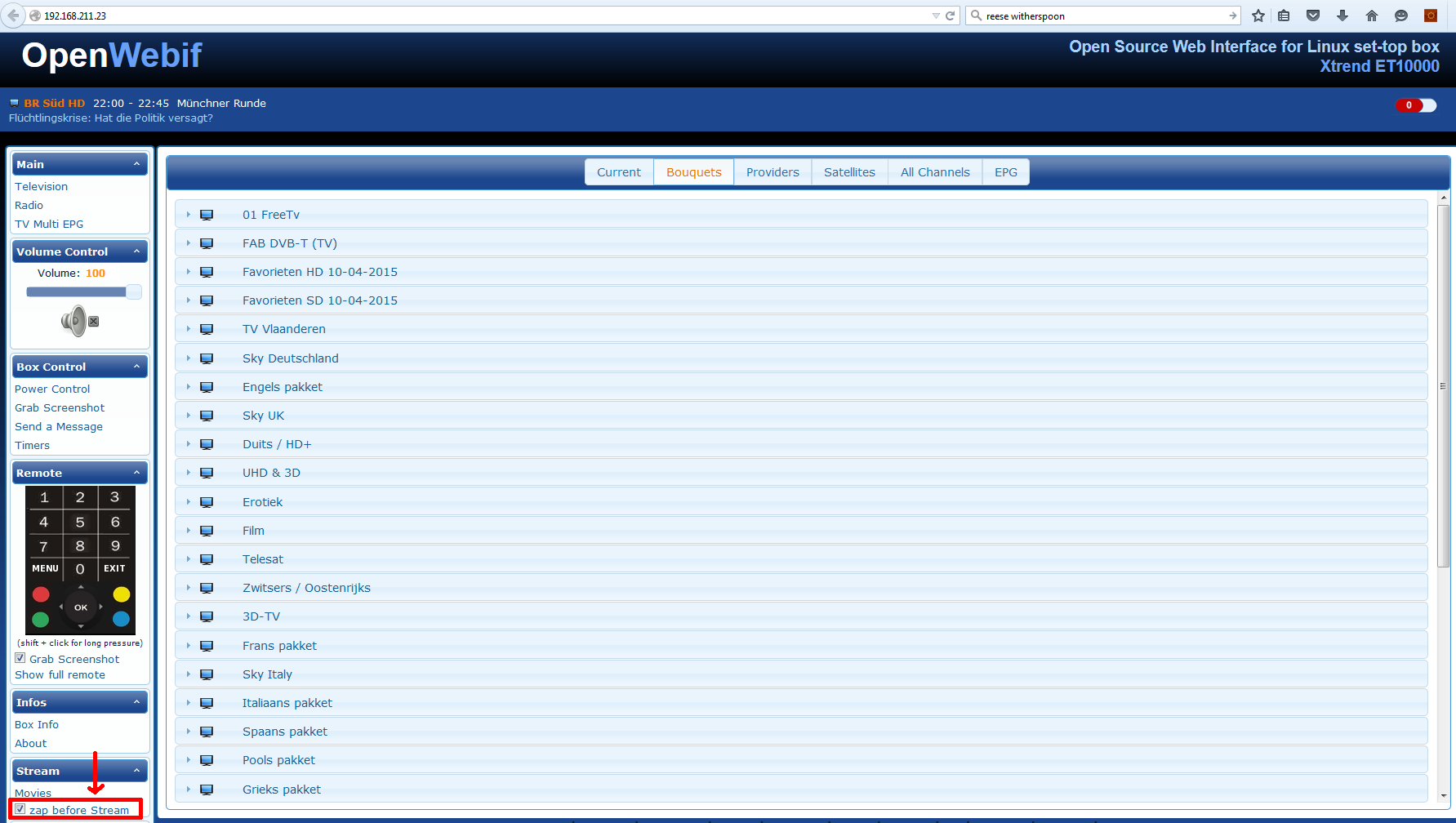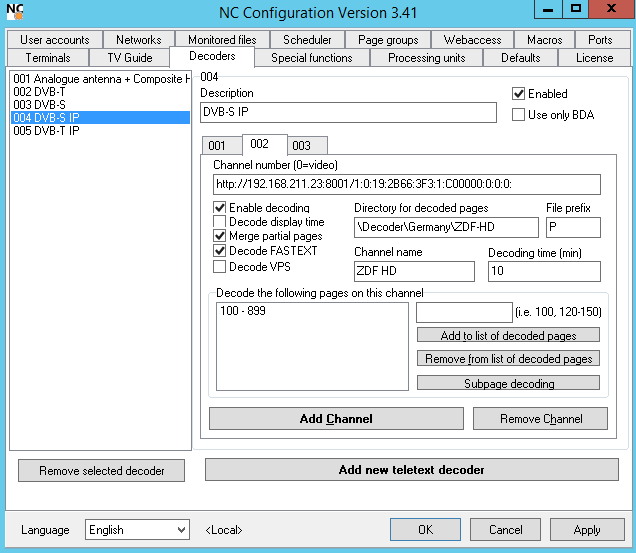FAB Network Controller supports the following teletext decoding sources:
- Hauppauge cards for analogue antenna and CVBS input
- Hauppauge cards for DVB-T, DVB-C and DVB-S/S2
- FAB FT-HT 1x cards for teletext decoding from SD/HD-SDI
- Linux based set top boxes
- Teletext in TS/IP Streams
Teletext decoding is configured in NC Configuration in the Decoders section. For every installed teletext decoder source one teletext decoder must be added to the list. The value of “Channel number” defines how the decoder source shall be used.
Hauppauge cards for analogue antenna and CVBS input
Hauppauge card HVR-1700 is supported.
The value of “Channel number” shall be 0 to decode teletext from CVBS input. It shall be a number to define the antenna channel number to decode from. The value can start with S to specify an S-Channel. Hauppauge cards do not work under Windows Server and therefore Windows 7/10 has to be used.
Hauppauge cards for DVB-T, DVB-C and DVB-S/S2
Hauppauge cards HVR-1700, HVR-4400 and HVR-5500 are supported. For every card and for every tuner on the card a separate teletext decoder must be created in the list of teletext decoders. Hauppauge cards do not work under Windows Server and therefore Windows 7/10 has to be used.
The value of the channel number must be a string containing pairs item=value separated by /.
Examples:
TUNERIDX=1/FREQ=11953500/SYMR=27500/MODU=QPSK/POLA=H/TSID=1079/ONID=1/SID=28006/PID=130
DVB-C:
TUNERIDX=1/FREQ=S24/SYMR=6900/MODU=256QAM/SID=11100
TUNERIDX=1/FREQ=C22/SYMR=6900/MODU=64QAM/SID=28725
DVB-S:
TUNERIDX=1/FREQ=11953500/SYMR=27500/MODU=QPSK/POLA=H/SID=28006
DVB-S2:
TUNERIDX=1/FREQ=11362000/SYMR=22000/MODU=8PSK/POLA=H/SID=11110
DVB-T:
TUNERIDX=1/FREQ=22/SID=150
TUNERIDX is the number of the tuner that shall be used if multiple cards are installed.
FREQ contains the frequency for reception of the antenna signal. The value “S10” would specify the DVB-C channel S10. The value “C10” would specify the DVB-C channel 10. A value between “1” and “69” would specify a DVB-T channel. A value between “47000” and “862000” would specify a reception frequency for DVB-T. A value higher than “10700000” and lower than “12750000” would specify a DVB-S(2) reception frequency.
SYMR specifies the symbol rate for DVB-C and DVB-S(2).
MODU specifies the modulation and must be one of the following values: 16QAM, 32QAM, 64QAM, 80QAM, 96QAM, 112QAM, 128QAM, 160QAM, 192QAM, 224QAM, 256QAM, 320QAM, 384QAM, 448QAM, 512QAM, 640QAM, 768QAM, 896QAM, 1024QAM, QPSK, BPSK, OQPSK, 8VSB, 16VSB, AM, FM, 8PSK, RF, 16APSK, 32APSK, NBCQPSK, NBC8PSK, DIRECTV, TTMCC, STMCC. For DVB-S the value is generally QPSK and for DVB-S2 the value is QPSK or 8PSK. For DVB-C/T the value is normally 16QAM, 64QAM or 256QAM.
POLA specifies the polarization for DVB-S(2). For DVB-C and DVB-T the value does not have to be specified.
TSID specifies the DVB transport stream ID. This parameter is optional. When TSID and ONID are ommited, any transport stream decoded on the specified frequency will be decoded.
ONID specifies the DVB original network ID. This parameter is optional. When TSID and ONID are ommited, any transport stream decoded on the specified frequency will be decoded.
SID specifies the DVB service ID.
PID specifies the teletext PID which shall be decoded. If this value is not specified, the PID used will be determined dynamically from the PMT of the service specified by the SID parameter.
Depending on the hardware used, the parameters SYMR and MODU may not be required.
FAB FT-HT 1x cards
FAB FT-HT 1x cards have two SDI inputs: Main and Aux. The value of the “Channel number” defines which input shall be used. The value 1 is Aux SDI input of card 1, the value 2 is Main SDI input of card 1, the value 3 is Aux SDI input of card 2 and the value 4 is Main SDI input of card 2. A separate teletext decoder must be created in the list of teletext decoders for every input.
Linux based set top boxes
Linux based set top boxes can be controlled over IP and provide a transport stream over IP which includes teletext. FAB Network Controller can receive the transport stream over http or udp and extract the teletext. The software option FT-NCIPDEC for FAB Network Controller is required for this functionality.
To configure the Linux set top box correctly please follow these steps:
- We recommend using XTrend ET-10000 receiver because it supports tuners for DVB-S2, DVB-T2 and DVB-C
- We recommend installing the OpenPLI firmware from www.openpli.org on the receiver because it includes the Open Webif Web Interface which provides easy control of the receiver from the web browser. The original firmware will probably also work, however the following screenshots were made with the OpenPLI firmware.
- Connect with a web browser to the receiver, i.e. http://192.168.0.123
- On the web interface enable “Zap before stream”

- Under “Bouquets” search for the channel that you wish to receive and click on “Stream”

- A file stream.m3u will be downloaded. Make sure to store the file on the disk and open it in a text editor. You will find the http URL for the transport stream in this file

- In NC Configuration / Decoders add a teletext decoder and use the URL in the Channel number field

- You can test the reception of the teletext by opening the file stream.m3u with the VLC from www.videolan.org and it shall display the video and also the integrated teletext decoder can be used.
Teletext in TS/IP Streams
FAB Network Controller can receive the transport stream over UDP and extract the teletext. The software option FT-NCIPDEC for FAB Network Controller is required for this functionality. In such case the ethernet output from a DVB receiver or directly from a DVB multiplexer would be connected to a free Ethernet port of FAB Network Controller.
To configure the teletext decoder to receive the teletext from TS/IP from a multicast IP address 239.192.1.1 on port 9200 in the PID 519 specify this decoding URL:
udp://239.192.1.1:9200?pids=519
The parameter ?pids=519 is not required if the TS stream contains only one channel with a PMT (Program Map Table) with the teletext descriptor.
This page was last updated on 2021-01-25